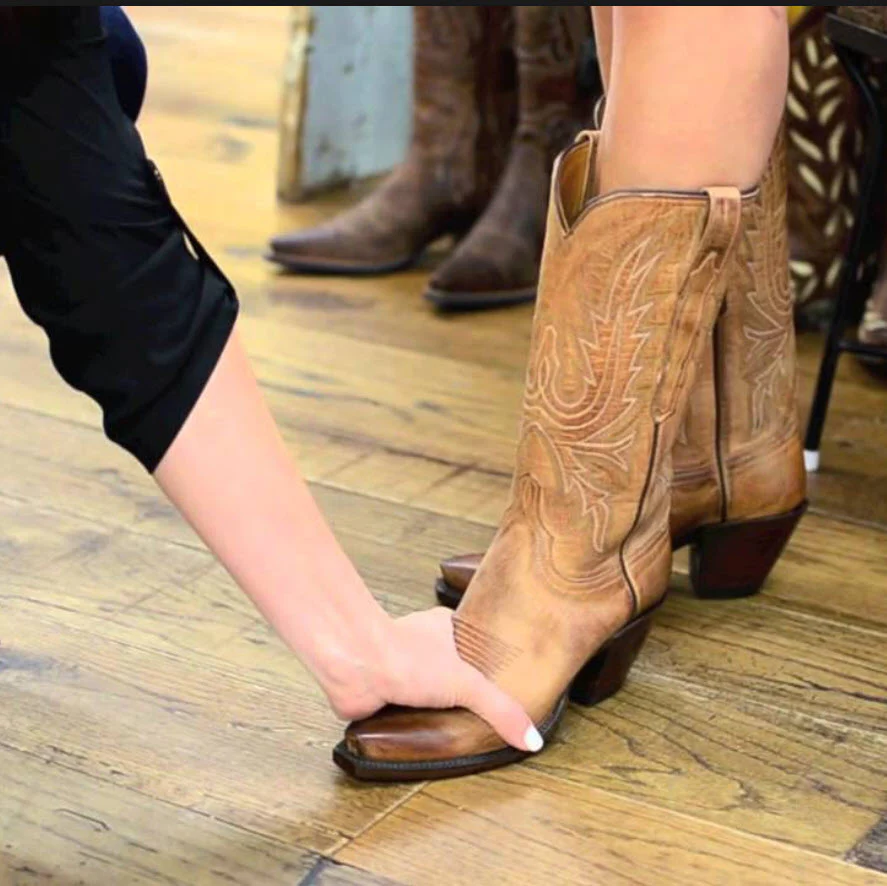How Should Cowboy Boots Fit? A Comprehensive Guide
Cowboy boots are a unique type of footwear that require a specific fit to provide comfort, support, and style. Unlike other shoes, cowboy boots are designed to fit snugly around the foot and ankle, with a narrow toe box and a high shaft. Achieving the perfect fit is crucial for both comfort and functionality, whether you’re a seasoned cowboy or a fashion enthusiast.In this comprehensive guide, we’ll explore the key factors to consider when fitting cowboy boots, provide step-by-step instructions for proper fitting, and address common questions and concerns.
Table of Contents
- Introduction
- Understanding Cowboy Boot Fit
- Importance of Proper Fit
- Differences from Other Footwear
- Key Areas of Fit
- Toe Box
- Ball of the Foot
- Instep
- Heel
- Fitting Cowboy Boots
- Measuring Your Feet
- Trying on Boots
- Checking for Proper Fit
- Breaking in Cowboy Boots
- Stretching Methods
- Conditioning the Leather
- Troubleshooting Common Fit Issues
- Tight Toe Box
- Loose Heel
- Discomfort in the Instep
- Maintaining Proper Fit
- Rotating Boots
- Resoling and Reheeling
- FAQs
- Conclusion
- References
Understanding Cowboy Boot Fit
Importance of Proper Fit
Proper fit is crucial for cowboy boots for several reasons:
- Comfort: A well-fitting boot will provide cushioning and support, reducing the risk of blisters, calluses, and other foot problems.
- Stability: A snug fit around the ankle and heel helps prevent slipping and sliding, ensuring stability and control while walking or riding.
- Durability: A properly fitted boot will last longer, as the leather and stitching are less likely to stretch or tear.
Differences from Other Footwear
Cowboy boots differ from other types of shoes in several key ways:
- Toe Box: Cowboy boots typically have a narrower toe box than other shoes, with a pointed or square toe.
- Heel: Cowboy boots have a higher heel than most other shoes, which helps provide stability and support while riding.
- Shaft: The shaft of a cowboy boot is taller than other shoes, extending up the calf and providing additional support and protection.
Key Areas of Fit
When fitting cowboy boots, there are several key areas to consider:
Toe Box
The toe box should be snug but not tight, allowing for a small amount of wiggle room. The toes should not touch the end of the boot, as this can cause discomfort and blisters.
Ball of the Foot
The ball of the foot should sit comfortably in the widest part of the boot, with no pinching or pressure.
Instep
The instep, or the area between the ball of the foot and the ankle, should feel snug but not restrictive. The boot should not feel too tight or too loose in this area.
Heel
The heel should fit snugly, with minimal slippage. A small amount of slippage is normal and will decrease as the boot breaks in.
Fitting Cowboy Boots
Measuring Your Feet
To ensure the best fit, it’s important to measure your feet before purchasing cowboy boots. Here’s how to do it:
- Stand on a flat surface with a piece of paper on the floor.
- Place your foot on the paper and mark the longest and widest points.
- Measure the distance between the marks and compare it to a size chart.
Trying on Boots
When trying on cowboy boots, follow these steps:
- Wear the socks you plan to wear with the boots.
- Slide your foot into the boot and pull up on the pull tabs or loops to secure it in place.
- Walk around in the boots to assess the fit.
Checking for Proper Fit
To ensure a proper fit, check the following:
- Toe Box: There should be a small amount of space between your toes and the end of the boot.
- Ball of the Foot: The ball of your foot should sit comfortably in the widest part of the boot.
- Instep: The instep should feel snug but not restrictive.
- Heel: The heel should fit snugly, with minimal slippage.
Breaking in Cowboy Boots
Breaking in cowboy boots is a process that can take several weeks or months, depending on the leather and your wear patterns. Here are some tips for breaking in your boots:
Stretching Methods
- Wear thick socks and walk around the house for short periods of time.
- Use a boot stretcher to expand the toe box and instep.
- Apply a leather conditioner to soften the material.
Conditioning the Leather
Conditioning the leather is important for maintaining the fit and appearance of your cowboy boots. Here’s how to do it:
- Clean the boots with a damp cloth to remove any dirt or debris.
- Apply a leather conditioner to the entire surface of the boot.
- Allow the conditioner to soak in for several minutes before buffing with a clean cloth.
Troubleshooting Common Fit Issues
Tight Toe Box
If the toe box feels too tight, try wearing the boots with thick socks and walking around the house for short periods of time. You can also use a boot stretcher to expand the toe box.
Loose Heel
If the heel feels too loose, try wearing the boots with thin socks and walking around the house for short periods of time. The heel should fit snugly, with minimal slippage.
Discomfort in the Instep
If the instep feels too tight or restrictive, try wearing the boots with thin socks and walking around the house for short periods of time. You can also apply a leather conditioner to soften the material.
Maintaining Proper Fit
To maintain the proper fit of your cowboy boots, follow these tips:
Rotating Boots
Rotate your boots regularly to prevent excessive wear and tear on any one pair. This will also help extend the life of your boots.
Resoling and Reheeling
Over time, the soles and heels of your cowboy boots will wear down. When this happens, take them to a professional cobbler for resoling and reheeling.
FAQs
How do I know if my cowboy boots fit properly?
To ensure a proper fit, check that the toe box is snug but not tight, the ball of your foot sits comfortably in the widest part of the boot, the instep feels snug but not restrictive, and the heel fits snugly with minimal slippage.
Can I wear cowboy boots with jeans?
Yes, cowboy boots can be worn with jeans. The key is to choose a pair of jeans that fits well over the boot shaft and doesn’t bunch up or create an unflattering silhouette.
How do I break in my cowboy boots?
To break in your cowboy boots, wear them with thick socks and walk around the house for short periods of time. You can also use a boot stretcher to expand the toe box and instep, and apply a leather conditioner to soften the material.
How often should I condition my cowboy boots?
Condition your cowboy boots every few months or whenever the leather starts to look dry or cracked. Use a high-quality leather conditioner and follow the manufacturer’s instructions.
Can I wear cowboy boots in the rain?
While cowboy boots are designed to be durable, they are not waterproof. If you plan to wear them in wet weather, consider applying a waterproofing spray or using a boot cover.
Conclusion
Achieving the perfect fit is essential for getting the most out of your cowboy boots. By understanding the key areas of fit, following proper fitting techniques, and maintaining your boots over time, you can ensure a comfortable and stylish ride for years to come.
References
For more information on cowboy boots and their fit, check out the Wikipedia page on Cowboy Boots.



